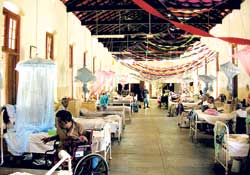
A princely hospital now lies in ruinsAlthough Sri Lanka no longer needs a leprosy hospital, its director is keen to renovate this 18th century building and turn it into a hospital dedicated to senior citizens While the Dutch were occupying Sri Lanka, and King Vira Narendra Sinha held out against the invaders from his kingdom in Kandy, one Dutch prince founded a hospital which was to have a tremendous impact on a great number of Sri Lankans, centuries down the line. The first occupant of the Leprosy Hospital was the prince himself, who having contracted leprosy, bought 20 acres of land from the Dutch government for the purpose of building a hospital. Three hundred years down the line, the hospital still has around four to five acres of land. The teak pillars in the corridors which run round each building still stand and the ancient boiler room can still be seen.
Unfortunately, what is left of the hospital is in a thoroughly derelict state. Dr. Dharshana Mohotti, the doctor in charge now hopes to convert it to a hospital for the elderly, as Sri Lanka is no longer in need of a leprosy hospital. It seems that we have come a long way from the time in which leprosy was something of a death sentence. Edward (79) came to the hospital at the age of fifteen, when he had to stop his education after contracting the disease. “We were considered a menace; a danger to society,” he recalled. “The hospital then had 12 foot high walls, and if any patient tried to get out, he or she would be arrested and brought back in handcuffs to the hospital. Until the country gained independence, we didn’t even have voting rights.” Life has improved now; with the discovery of medication which does not have harmful side effects, the fear of leprosy is now more or less non existent. “Even the stigma that was attached to leprosy is no longer an issue,” says Dr. Mohotti. The hospital is said to have started off with thousands of patients, but, three centuries later, the number has dwindled to a mere 56. “These patients are now fully cured. There is no leprosy germ here,” says Dr. Mohotti. “However, they have to stay here because they suffer from various disabilities as a result of the disease.” He said that the main problem faced by the hospital is that the patients lead extremely bleak, lonely lives in the hospital, and one of the goals of the staff is to convert one of the unused buildings of the hospital into a recreational centre. “Sri Lanka now has a growing elderly population, and right now there is no hospital that is dedicated to catering to the needs of senior citizens,” explains Dr. Mohotti, adding that the leprosy hospital has no future if it remains as it is. This is because leprosy has now been eradicated from Sri Lanka. The number of new leprosy patients is less than one per 10,000 of the population. The World Health Organization decreed that leprosy should be fully eradicated by 2000, but Sri Lanka achieved this by 1995. The disease can now be treated with no resulting disfiguration or disability. Thus the staff of the hospital eagerly awaits approval from the Health Ministry to renovate the place and convert it to a hospital for the elderly.
Until this time, all effort is concentrated on the well being of the patients. According to Dr. Mohotti, what the patients need now is understanding and appreciation. There had been a time when they were extremely restless and unhappy.“When I came here, in general, the attitudes were negative. But things have changed because we have been able to see the true picture, thereby achieving a better understanding of our patients.” What has been achieved so far is remarkable, but there is much to be done- the 56 patients between the ages of 30 to 101 to whom this crumbling hospital is home, deserve more. A dream come true On January 13, the Leprosy Hospital took its occupants on a pilgrimage to Anuradhapura sponsored by the Junior Old Boys Association of Nalanda College. “One of our patients had a lifelong dream of going to Anuradhapura, and I was determined to at least take him there,” says Dr. Mohotti. “If not for our sponsors, we would never have been able to take all our patients on the pilgrimage, and we are extremely thankful to them. The experience has really made a difference in their lives.” “Our pilgrimage to Anuradhapura was a very inspiring experience, and we really appreciate the effort made to get us there,” says K. Premadasa Fernando, one of the patients, adding that they are all happy and contented with their lives. “The care we get here is unequalled, and the treatment we get here is a pleasant change from what we used to face in the outside world.” |
|| Front
Page | News | Editorial | Columns | Sports | Plus | Financial
Times | International | Mirror | TV
Times | Funday
Times || |
| |
Reproduction of articles permitted when used without any alterations to contents and the source. |
© Copyright
2008 | Wijeya
Newspapers Ltd.Colombo. Sri Lanka. All Rights Reserved. |

